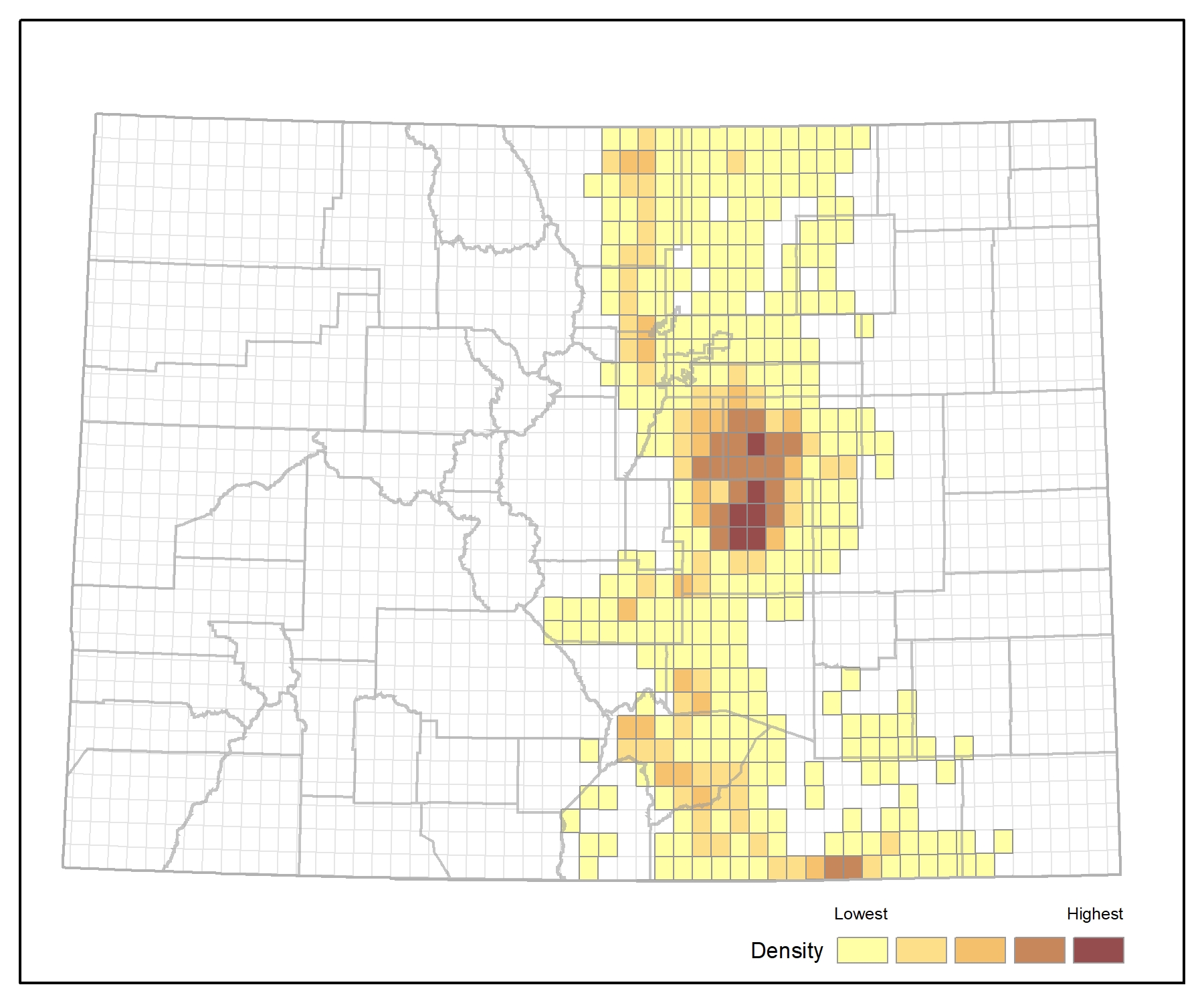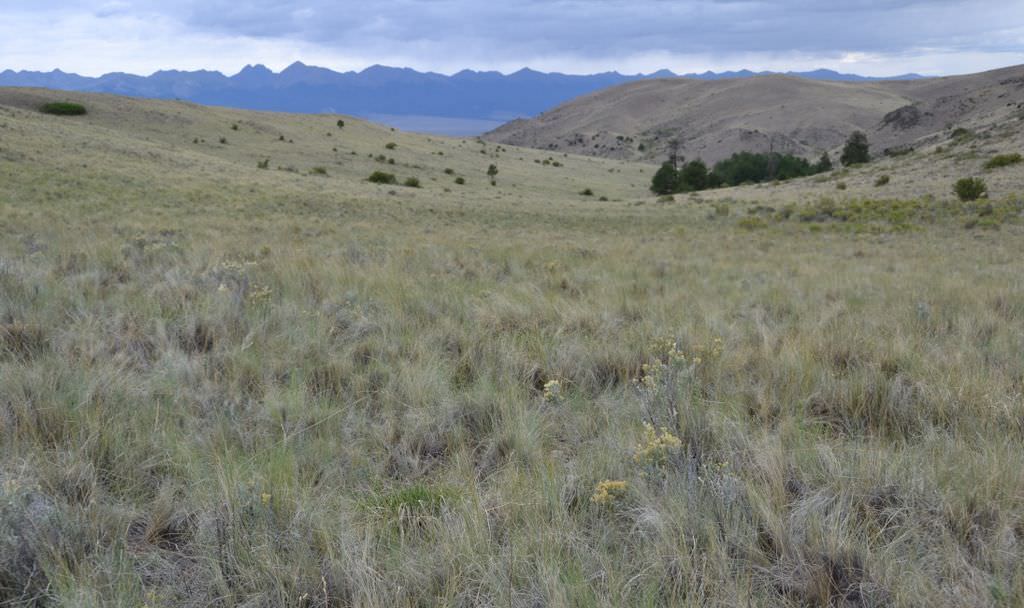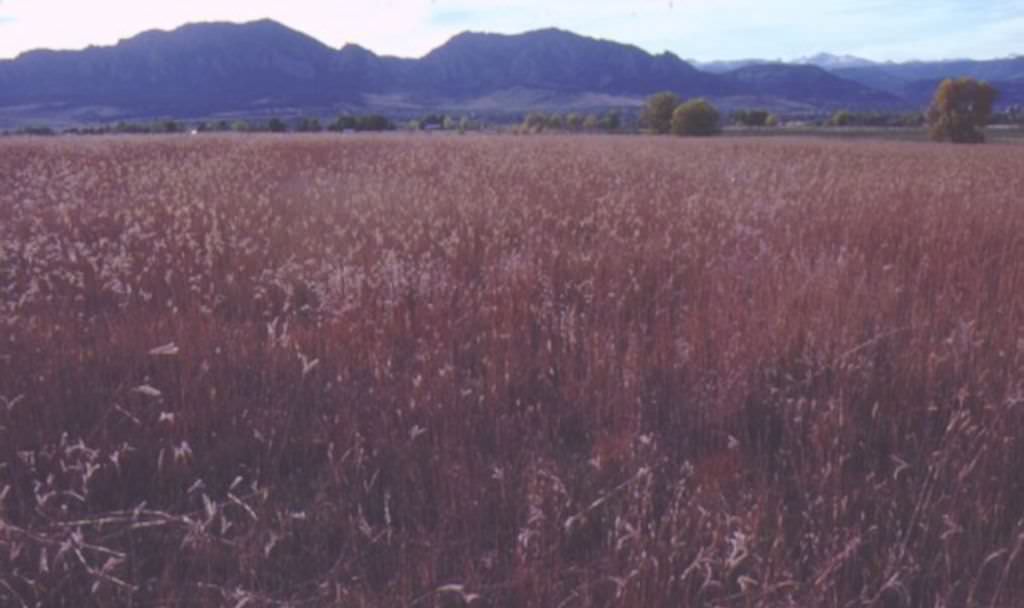Western Great Plains Foothill and Piedmont Grassland
Click link below for details.
General Description
These grasslands are found at the extreme western edge of the Great Plains, where increasing elevation and precipitation facilitate the development of mixed to tallgrass associations on certain soils. The Colorado piedmont is the area between the foothills and the remnant surface of the High Plains to the east, a broad basin eroded by the drainages of the South Platte and Arkansas rivers. This large patch system typically occurs between 1,600 and 2,200 m (5,250-7,200 feet) in elevation. Most occurrences can be characterized as a mixed- to tall-grass dominated system on typically found on moderate to gentle slopes and in swales, primarily occuring as a relatively narrow elevational band between montane woodlands and shrublands and the shortgrass steppe. The system also extends east on the Front Range piedmont alongside the Chalk Bluffs at the Colorado-Wyoming border, out into the Great Plains on the Palmer Divide, and on slopes below mesas and foothills in southeastern Colorado and northeastern New Mexico. Colorado occurrences of this system may be dominated by big bluestem (Andropogon gerardii), little bluestem (Schizachyrium scoparium), sideoats grama (Bouteloua curtipendula), green needlegrass (Nassella viridula), western wheatgrass (Pascopyrum smithii), sand dropseed (Sporobolus cryptandrus), needle-and-thread (Hesperostipa comata), or New Mexico feathergrass (Hesperostipa neomexicana). Remnant stands of "tallgrass prairie in mesic areas near the mountain front can be considered a special component of this system, since tallgrass communities of the foothills and piedmont are disjunct from the Great Plains tallgrass prairie with large expanses of mid-grass and shortgrass prairies in between.
Diagnostic Characteristics
These are mixedgrass communities of areas on the western margin of the shortgrass prairie region; disjunct from mixedgrass prairie types east of Colorado. Prior to European settlement, grassland communities were probably common in Rocky Mountain foothills, mesas, hogbacks, small drainages, and swales that are now largely under or surrounded by urban and suburban development. Remnants of these grasslands can still be found in undeveloped areas, and, although often highly altered, are characterized by the presence of mid- to tallgrass species.
Typical adjacent ecological systems include foothill shrublands, ponderosa pine savannas and woodlands, and pinyon-juniper savannas and woodlands as well as shortgrass prairie and periodic foothills riparian corridors. Together, these systems may form a complex mosaic of vegetation in the ecotonal foothill region.
Similar Systems
Southern Rocky Mountain Montane-Subalpine Grassland: These grasslands of higher elevations occasionally intergrade with montane-subalpine grasslands at elevations below 7,500 ft, but are characterized by montane to subalpine species including muhly (Muhlenbergia spp.), bluebunch wheatgrass (Pseudoroegneria spicata), Arizona fescue (Festuca arizonica), and Idaho fescue (Festuca idahoensis).
Northwestern Great Plains Mixedgrass Prairie: Mid-height grasses are also characteristic of these grasslands to the north. A few stands of this type may occur along the Colorado-Wyoming border, but in Colorado these would be assigned to the foothill and piedmont system.
Range
This grassland type is found in the transitional zone between the Rocky Mountains and the western Great Plains. It occurs along the mountain front from New Mexico to Wyoming, and is also found along the margins of mesas and uplifts in the panhandles of Texas and Oklahoma, and the edges of the Black Hills in South Dakota.
Ecological System Distribution

Spatial Pattern
Western Great Plains Foothill and Piedmont Grassland is a large patch type.
Environment
The western Great Plains has a continental climate with both east-west and north-south gradients. Over the central plains, precipitation decreases from east to west, while temperatures and day-lengths increase from north to south. Near the mountain front, precipitation increases again with increasing elevation, permitting the growth of taller grass species than are characteristic of the shortgrass prairie that once dominated most of Colorado's eastern plains. The Colorado piedmont is the area between the foothills and the remnant surface of the High Plains to the east, a broad basin eroded by the drainages of the South Platte and Arkansas rivers. Grasslands of the foothills and piedmont are typically found between 1,600 and 2,200 m (5,250-7,200 feet) in elevation on the comparatively narrow band of hill and mesa landforms dissected by small streams at the mountain front, but may extend or occur disjunctly to the east where topography, soils, and precipitation patterns are similar. Soils are typically well-drained alluvial material, often cobbly. In areas where mesa landforms occur, seeps on slopes below the caprock may support more mesic associations.
Vegetation
Colorado occurrences of this system may be dominated by big bluestem (Andropogon gerardii), little bluestem (Schizachyrium scoparium), blue grama (Bouteloua gracilis), sideoats grama (Bouteloua curtipendula), green needlegrass (Nassella viridula), western wheatgrass (Pascopyrum smithii), sand dropseed (Sporobolus cryptandrus), needle-and-thread (Hesperostipa comata), or New Mexico feathergrass (Hesperostipa neomexicana). Other graminoids that are often present include mountain muhly (Muhlenbergia montana), threeawn (Aristida spp.), prairie Junegrass (Koeleria macrantha), and sun sedge (Carex inops ssp. heliophila).
Forbs are usually present with 10-40% cover and diversity can be high, although non-native species are usually present. Common native species include nodding onion (Allium cernuum), prairie sagewort (Artemisia frigida), milkvetch (Astragalus spp.), curlycup gumweed (Grindelia squarrosa), little sunflower (Helianthus pumilus), hairy false goldenaster (Heterotheca villosa), dotted blazing star (Liatris punctata), sidebells penstemon (Penstemon secundiflorus), slimflower scurfpea (Psoralidium tenuiflorum), and upright prairie coneflower (Ratibida columnifera). Scattered shrubs include nylon hedgehog cactus (Echinocereus viridiflorus), pricklypear (Opuntia spp.), broom snakeweed (Gutierrezia sarothrae), and soapweed yucca (Yucca glauca).
- CEGL001463 Andropogon gerardii - Schizachyrium scoparium Northwestern Plains Grassland
- CEGL001464 Andropogon gerardii - Sorghastrum nutans West-Central Plains Grassland
- CEGL001465 Andropogon gerardii - Sporobolus heterolepis Western Foothills Grassland
- CEGL001754 Bouteloua gracilis - Bouteloua curtipendula Grassland
- CEGL001756 Bouteloua gracilis - Bouteloua dactyloides Grassland
- CEGL001755 Bouteloua gracilis - Bouteloua hirsuta Grassland
- CEGL001760 Bouteloua gracilis Grassland
- CEGL001703 Hesperostipa comata - Achnatherum hymenoides Grassland
- CEGL001702 Hesperostipa comata Colorado Front Range Grassland
- CEGL001708 Hesperostipa neomexicana Grassland
- CEGL001713 Nassella viridula Grassland
- CEGL001583 Pascopyrum smithii - Nassella viridula Grassland
- CEGL001677 Pseudoroegneria spicata - Poa secunda Grassland
- CEGL001660 Pseudoroegneria spicata Grassland
- CEGL001594 Schizachyrium scoparium - Bouteloua curtipendula Western Great Plains Grassland
Associated Animal Species
Grazing and browsing herbivores that have been historically associated with these grasslands include mule deer (Odocoileus hemionus), elk (Cervus elaphus), and pronghorn (Antilocapra americana). Small grazing and burrowing mammals such as pocket gophers (Thomomys spp.), black-tailed prairie dog (Cynomys ludovicianus), rabbits (Sylvilagus spp.), and ground squirrels are typically present, and preyed upon by raptors. The ecotonal nature of these grasslands is believed to contribute to the presence of numerous butterfly species, including several rare species.
Dynamic Processes
Although grasslands are generally believed to be influenced by fire, little is known about fire dynamics in this system as compared to the larger grassland systems of the Great Plains. The tendency of foothill and piedmont grasslands to intermix with adjacent systems is likely to effect the fire dynamics within the system. Fuel loads in these mid- to tallgrass communities are typically higher than in adjacent shortgrass, which may historically have resulted in more frequent fires.
This system was naturally subject to grazing and browsing by native herbivores including deer, elk, bison, and pronghorn, as well as burrowing and grazing by small mammals. Activities of these animals can influence both vegetation structure and soil disturbance. Periodic drought is common in the Western Great Plains, but may not be as great a factor in the vegetation dynamics of this system as in grasslands of the plains.
In the absence of disturbance such as grazing and fire, dead plant material accumulates on the surface. In comparison with wetter regions, decomposition is slow in these semi-arid grasslands and nutrients may accumulate in litter. Wind and water erosion can remove nutrients. Fire quickly returns nutrients to the soil. Herbivory has a much greater influence on energy and nutrient pathways in grasslands than in forests, and a greater proportion of biomass is moving through the grazing pathway in comparison to other ecosystems.
Management
Western Great Plains Foothill and Piedmont Grassland is one of the most severely altered systems in the ecoregion. Along the Front Range, the zone historically occupied by these grasslands has proved to be highly favored for housing and water development, as well as agricultural activities including hay meadows and domestic livestock grazing. As a result, virtually all occurrences of this system have been severely fragmented and invaded by non-native species, or lost entirely through land use conversion. The best remaining areas are generally within local or regional open space lands. The generally fair to poor condition of many occurrences in Colorado may tend to inhibit the potential of this ecosystem to persist or move into new areas under future climate conditions.
References
- Borchert, J.R. 1950. The climate of the central North American grassland. Annals of the Association of American Geographers, 40(1):1-39.
- Branson, F.A., R.F. Miller, and I.S. Mcqueen. 1961. Soil-water availability and use by grasslands on adjacent stony and shale-derived soils in Colorado. Short papers in the Geologic and Hydrologic Sciences. 147(292): 251-253.
- Collins, S.L, and S.M. Glenn. 1995. Grassland ecosystem and landscape dynamics. pp. 128-156 in Joern, A. and K.H. Keeler, eds., The Changing Prairie: North American grasslands. Oxford University Press. New York.
- Lauenroth, W.K. 1979. Grassland primary production: North American grasslands in perspective. Pages 3-24 in Perspectives in Grassland Ecology, N.R. French ed. Springer-Verlag, New York.
- Sims, P.L., and P.G. Risser. 2000. Grasslands. Chapter 9 in: Barbour, M.G., and W.D. Billings, eds., North American Terrestrial Vegetation, Second Edition. Cambridge University Press, New York.
- Weaver, J. E., and F. W. Albertson. 1956. Grasslands of the Great Plains: Their nature and use. Johnsen Publishing Co., Lincoln, NE. 395 pp.








